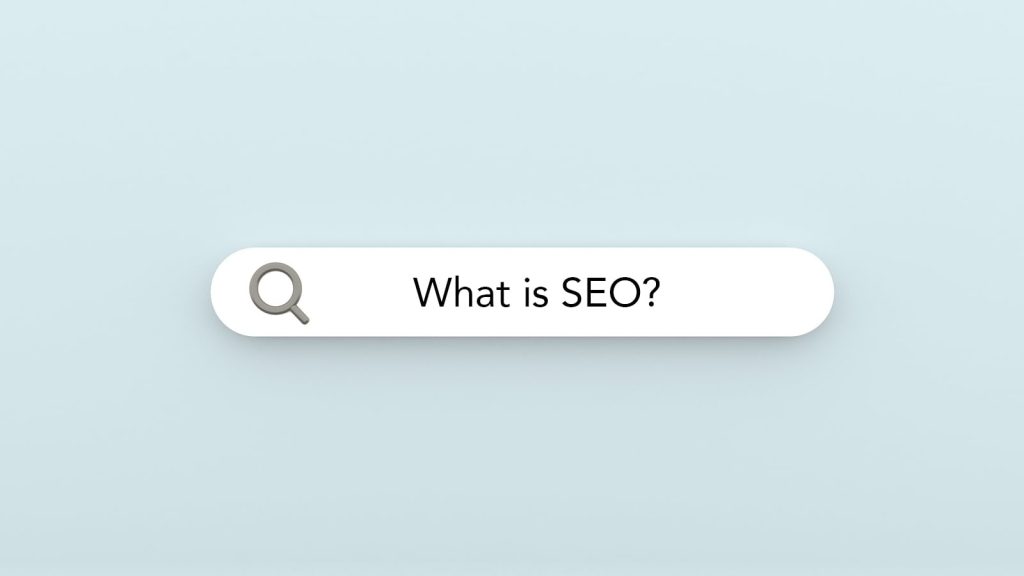Curious about how websites make it to the top of search results? A common question that gets asked by small business owners is, “What is SEO?” Let’s dive into the world of SEO. Understanding search engine optimization can significantly impact your online presence.
From learning how search engines work to optimizing your website both on and off the page, there’s a lot to explore. By unraveling the mysteries of SEO, you can enhance your digital strategy and improve your online visibility.
What is SEO?
Understanding SEO is essential for success in the online world. SEO, short for Search Engine Optimization, involves optimizing various elements on a website to improve its visibility in organic search engine results. For example, when you do a Google Search, what comes at the top of the search?
By focusing on aspects like content, keywords, and metadata, you can enhance your site’s ranking on search engine results pages. This optimization process increases the likelihood of your website appearing higher in search results when users search for relevant queries. Ultimately, SEO plays a crucial role in driving organic traffic to your website and attracting potential customers. SEO is a type of digital marketing.

Why is SEO Important?
Understanding the importance of SEO is essential for boosting your website’s visibility and effectively reaching your target audience.
Why should you care about SEO? SEO is extremely important for small businesses and businesses of all sizes.
SEO, or search engine optimization, is key to driving traffic to your site through organic search results. By optimizing your website, you improve its visibility, making it easier for potential customers to discover you.
This enhanced visibility not only increases organic traffic but also helps achieve important business objectives like conversions and sales.
Investing in SEO is a smart decision to ensure your website ranks well on search engines, leading to improved visibility and more opportunities to engage with your target audience.
How Do Search Engines Work?
Understanding how search engines like Google, Bing, and Yahoo operate is essential for boosting your website’s visibility, effectively reaching your target audience through SEO, and knowing how SEO works. These search engines use automated programs known as crawlers to browse the web by following links from one page to another. The crawlers collect information about the content they discover and categorize it based on its relevance and quality. When users enter search queries, the search engine retrieves and ranks results from its index, taking into account factors such as keywords, backlinks, and user experience.
To ensure that your website appears in search results, it’s vital to optimize your content for indexing by using relevant keywords and providing valuable information that resonates with searchers. By understanding the intricacies of search engine operations, you can maximize your SEO efforts and improve your website’s performance.
It’s important to note that search engines continuously update their algorithms to provide users with the most relevant and useful results. Staying informed about these updates and adapting your SEO strategies accordingly can help you stay ahead in the ever-evolving digital landscape. By focusing on creating high-quality, engaging content and following best SEO practices, you can enhance your website’s visibility and attract more organic traffic.

On-page SEO
On-page SEO is also known as on-site SEO. When optimizing your webpage for search engines and users, focus on key elements like:
- Content quality
- Title tag relevance
- Mobile friendliness
- Page load speed
- Ensuring SSL/HTTPS security
These factors play a vital role in determining your page’s visibility and ranking on search engine results pages. Prioritize these aspects to enhance your on-page SEO strategy and attract more organic traffic to your website.

Content Quality
Optimizing content quality is crucial for on-page SEO as it directly impacts website visibility and user engagement. When it comes to enhancing content quality, there are several key considerations:
- User Experience: High-quality content plays a vital role in improving user experience by keeping visitors engaged and encouraging longer page visits.
- SEO Strategies: Quality content is a foundational element of effective SEO strategies, influencing search engine rankings and driving organic traffic to the website.
- Website Security: Maintaining content quality is essential for establishing trust with both users and search engines, contributing to overall website security.
Title Tag
Optimizing the title tag is a crucial element in boosting your website’s visibility and search engine performance. The title tag, an HTML element that denotes the title of a webpage, serves as the clickable headline on search engine results pages. By incorporating relevant keywords into the title tag, you can significantly enhance your on-page SEO efforts.
Meta tags, including the title tag, play a pivotal role in optimizing for search engines. Conducting an SEO audit can pinpoint areas for improvement, such as optimizing title tags for better results. Ensure that your title tags are concise, descriptive, and feature relevant keywords to improve your website’s search visibility.

Mobile Friendliness
Mobile friendliness plays a crucial role in on-page SEO, significantly impacting both user experience and search engine rankings. Here are some key aspects to consider for optimizing mobile SEO:
- Responsive Design: It’s essential to ensure that your website is designed in a way that adapts seamlessly to different mobile devices. This helps in providing a consistent and user-friendly experience across various screen sizes.
- Mobile-First Indexing: Google gives preference to mobile-friendly websites when it comes to indexing and ranking. Ensuring that your site is optimized for mobile can greatly improve its visibility in search engine results.
- Mobile Site Speed Optimization: Optimizing the loading speed of your mobile site is crucial for retaining visitors and improving SEO rankings. Faster loading times not only enhance user experience but also contribute to better search engine performance.
With mobile devices accounting for over 60% of organic search visits, focusing on mobile SEO is imperative. By prioritizing mobile site configuration, responsiveness, and speed optimization, you can stay competitive in the ever-evolving digital landscape.

Page Load Speed
Improving page load speed is crucial for enhancing on-page SEO performance and user experience. A fast-loading website not only provides a better user experience but also positively impacts SEO rankings. Google’s Core Web Vitals, which include metrics like Largest Contentful Paint (LCP), First Input Delay (FID), and Cumulative Layout Shift (CLS), play a significant role in guiding page speed optimization efforts.
To monitor and improve page load time, utilizing tools such as Google PageSpeed Insights and GTmetrix is essential. These tools help in identifying areas that need improvement and provide insights into optimizing website performance. Strategies like image compression, reducing HTTP requests, and implementing browser caching can effectively boost page speed and overall SEO performance.
Prioritizing Core Web Vitals is key to ensuring that your website offers a seamless user experience. By implementing the recommended optimizations, you can’t only enhance user satisfaction but also positively influence your SEO rankings. Keeping an eye on page load speed and making necessary improvements will help your website stay competitive in the online landscape.

SSL/HTTPS
Considering the crucial role that SSL/HTTPS plays in improving on-page SEO performance and ensuring secure data transmission on your website is essential. Implementing HTTPS with SSL certificates is vital for safeguarding data privacy and security. Here are three key points to keep in mind:
- Enhanced Security: SSL certificates encrypt data exchanged between the server and the browser, thwarting unauthorized access attempts.
- Improved Search Rankings: Google gives preference to HTTPS sites in search results, which can positively impact your rankings.
- Data Privacy: HTTPS provides a secure layer for sensitive information, creating a safe online environment for your website visitors.
URL Structure
When it comes to optimizing your website for security and SEO performance, paying attention to the on-page SEO aspect of URL structure is essential.
While the impact of keywords in URLs on search rankings has diminished over time, they still play a role in user interaction. Anchor text remains crucial for linking strategies, as naked links don’t offer the same SEO benefits.
Including relevant keywords in URLs can help users understand webpage content, aligning with user-focused SEO practices. To create an SEO-friendly URL structure, use lowercase letters, hyphens for visibility, and accurate keywords without unnecessary elements.
Consistent and clear URL structures not only enhance user experience but also help prevent linking errors.
Meta Descriptions
Crafting effective meta descriptions plays a crucial role in improving click-through rates and engaging users on your website. Here are some key points to consider for on-site SEO:
- Optimal Length: Keep your meta descriptions between 50-160 characters for better visibility on Google SERPs.
- Writing Tips: Craft unique and keyword-rich descriptions to avoid duplication and entice users to click.
- Impact on Click-Through Rate: While not a direct ranking factor, well-written meta descriptions can influence user behavior and boost click-through rates.
Headings (H1, H2, H3, etc.)
Header tags, including h1 to h6 in HTML, play a vital role in structuring content and improving readability on websites. Using header tags correctly helps in organizing content and creating a more user-friendly experience.
It’s important to include relevant keywords in your header tags for better SEO optimization. Google relies on header tags to understand the context of your page, so placing keywords strategically can boost visibility. Remember to prioritize readability over cramming keywords to ensure a seamless user experience.

Keyword Optimization
Mastering the art of keyword optimization is essential for effective On-page SEO implementation to improve your website’s visibility and attract organic traffic. By conducting thorough keyword research, you can align your content strategy with search algorithms, maximizing the impact of your on-page optimization efforts.
Here are three key steps to optimize your keywords effectively:
- Start by conducting comprehensive keyword research to identify high-traffic and relevant keywords that resonate with your target audience.
- Strategically integrate these keywords into your website content in a natural and seamless manner, ensuring they enhance the overall user experience.
- Regularly monitor keyword performance and adapt your strategy to keep pace with evolving search engine optimization trends, ensuring long-term success.
Internal Linking
Strategically incorporate internal linking to improve on-page SEO performance and increase website visibility effectively. Internal linking is a critical aspect of on-page optimization as it connects different pages within your website through hyperlinks.
By placing internal links thoughtfully with relevant anchor text, you can enhance website structure, guide users, and assist search engines in navigating essential pages. Utilize internal linking to establish a logical information flow, distribute link equity, and improve the visibility of key pages.
This practice enhances user experience and facilitates search engine crawling and indexing. It’s important to strike a balance between internal linking and backlinks to develop a robust SEO strategy that leverages both elements effectively.
Alt Text for Images
When it comes to optimizing your website for search engines, adding descriptive alt text to your images is crucial for improving accessibility, user experience, and search engine visibility.
Here are some key points to consider:
- Alt text helps Google understand the content of your images, which can lead to improved visibility in search results.
- Providing contextual alt text can enhance Google’s Search Generative Experience and boost the visibility of your products or services.
- Optimized alt text can attract organic views, catering to users who prefer visual search results.
Schema Markup
Alt text for images is important for search engine optimization, and Schema Markup is a key element in enhancing the visibility and context of your webpages in search results. Schema markup, also known as structured data, helps search engines better understand your content, which can lead to the creation of rich snippets in search engine results pages (SERPs). Google Structured Data Markup Helper is a useful tool for effectively adding schema markup to your webpages.
While schema markup may not directly impact organic search rankings, it significantly improves how your website appears in search results, potentially boosting click-through rates. By providing structured data, schema markup ensures that search engines display more accurate and relevant information to users. It helps search engines present your content in a more organized and informative manner, making it easier for users to find what they’re looking for.
Off-page SEO
When it comes to off-page SEO (also known as off-site SEO), your focus should be on building quality backlinks, leveraging social signals, and establishing trust with your audience.
Off-page optimization gives signals to Google and other search engines from other websites and sources that you’re a trusted and reputable website.

Backlinks
Backlinks are crucial in SEO as they enhance search rankings by validating content credibility and usefulness through external validation. Building backlinks is also known as link building. When it comes to building backlinks, here are some key considerations:
- Creating Linkable Assets: Develop valuable content such as informative blog posts or engaging videos that naturally attract backlinks from other websites.
- Implementing Effective Strategies: Utilize proven techniques like participating in link roundups or leveraging the Moving Man Method to acquire high-quality backlinks from authoritative sources.
- Ensuring SEO Success: Prioritize quality over quantity when acquiring backlinks, regularly monitor your backlink profile for any suspicious activity, and explore advanced strategies like Help a Reporter Out (HARO) and analyzing competitors’ backlink profiles to enhance your link-building efforts.
Remember, quality backlinks are essential for enhancing your website’s visibility on search engine result pages.

Social Signals
Improving your website’s search engine visibility involves strategically incorporating social signals into your off-page SEO strategy to increase audience engagement and enhance rankings effectively. Social signals, like interactions on Twitter and creating high-quality content, play a vital role in influencing search engine rankings.
It’s important to build a strong presence on platforms where your target audience is active to boost social signals and conversions. Tailoring engaging content can result in more backlinks and better rankings. Establishing trust through social proof and valuable content is crucial for building credibility with your audience.
Consistently interacting with customers on social media, collaborating with influencers, and maintaining a consistent brand presence are essential strategies to strengthen social signals and enhance your SEO efforts.
Trust
Establishing credibility and authority in off-page SEO hinges on understanding the pivotal role of trustworthiness. When it comes to prioritizing trust in your SEO strategy, consider the following key aspects:
- Building a Strong Reputation: Cultivating a reputable image over time is essential for users and search engines to perceive your website as trustworthy. Consistent delivery of quality content and services contributes significantly to building trust.
- Demonstrating Expertise and Authority: Showcasing your knowledge and authority in your content creation is vital for establishing credibility and achieving higher organic rankings. Providing valuable insights and relevant information positions you as a reliable source in your industry.
- Enhancing User Engagement: Emphasize the creation of high-quality content that fosters meaningful interactions with your audience. Improving engagement metrics such as time on page and reducing bounce rates signifies a positive user experience and strengthens trust in your website.
How to Learn SEO
Learning SEO effectively involves a methodical approach that includes technical SEO, on-page SEO, and off-page optimization strategies. If you’re a webmaster looking to start your SEO journey, start by exploring foundational resources such as reputable websites, informative books, and instructional videos. Consider enrolling in SEO courses, participating in industry conferences, and subscribing to newsletters to expand your knowledge base. It’s essential to verify the credibility of your sources to stay informed about the latest developments in the field.
Consistent practice is key to gaining practical experience in SEO. Monitor your progress by tracking metrics like visibility, clicks, and conversions. Keep in mind that becoming proficient in SEO takes time and dedication, requiring continuous effort across all aspects of SEO learning. Stay adaptable to algorithm updates and refine your tactics to enhance your SEO skills.
Frequently Asked Questions
What’s the difference between SEO vs. SEM?
SEO focuses on organically optimizing a website for traffic whereas SEM focuses on organic and paid advertising to gain traffic. Paid advertising includes Pay Per Click (PPC) advertising.
What Are Some SEO Tools To Help With SEO Optimization?
Some popular SEO tools include Semrush, Ahrefs, Google Keyword Planner, Google Search Console, and Google Analytics.
How Does Local SEO Differ From Traditional SEO Practices?
Local SEO differs from traditional SEO in its focus on specific geographical areas to enhance targeted visibility. By tailoring content, keywords, and backlinks to local audiences, businesses can effectively reach their local market. In contrast, traditional SEO aims to reach broader audiences on a national or global scale.
To achieve success in local SEO, it is essential to enhance local citations, optimize Google My Business profiles, and encourage positive reviews from local customers. These strategies help businesses establish a strong online presence within their local community and attract nearby customers searching for products or services.
What Role Do Backlinks Play in SEO and How Can They Be Effectively Utilized?
Backlinks are crucial for SEO success as they play a significant role in boosting your website’s authority, credibility, and visibility in search engine results. It’s important to focus on quality rather than quantity when acquiring backlinks. Prioritize obtaining links from relevant and reputable sources within your industry to establish a strong link profile that positively impacts your SEO efforts.
By building a natural link profile with high-quality backlinks, you can improve your website’s search engine rankings and attract more organic traffic. It’s essential to engage in ethical link-building practices and avoid any black hat SEO techniques that could harm your site’s reputation in the long run.
Remember that backlinks are not just about increasing the number of links pointing to your site; they should also be relevant and add value to the user experience. By earning backlinks from authoritative websites and influencers in your niche, you can enhance your online presence and establish your website as a trusted resource in your industry.
How Does Voice Search Impact SEO Strategies and Optimization Techniques?
When considering the impact of voice search on SEO strategies, it is essential to prioritize optimization for natural language queries, featured snippets, and local search results. Content should be crafted in a conversational tone, keeping it concise and ensuring it is optimized for mobile devices. It is crucial to stay updated with voice search trends and regularly adjust strategies accordingly. By focusing on these key areas, businesses can enhance their online visibility and better meet the needs of voice search users with the latest voice search optimization techniques.
What Are the Key Differences Between White Hat and Black Hat SEO Practices?
When differentiating between white hat and black hat SEO practices, it’s important to understand that white hat techniques prioritize ethical strategies that comply with search engine guidelines. These methods aim to improve your website’s ranking in a sustainable and long-lasting way. On the other hand, black hat SEO involves using deceptive tactics to achieve quick results, but this approach can lead to penalties and damage your site’s reputation and visibility over time.
White hat SEO strategies typically involve creating high-quality content that is valuable to users, optimizing website structure and metadata, and building quality backlinks from reputable sources. These practices not only help improve your search engine rankings but also enhance the overall user experience on your site.
In contrast, black hat SEO techniques may include keyword stuffing, cloaking, buying links, and other manipulative tactics that violate search engine guidelines. While these tactics can lead to temporary gains in search rankings, they are ultimately unsustainable and can result in your site being penalized or banned from search engine results.
How Can Structured Data Markup Enhance SEO Performance and Visibility in Search Results?
Structured data markup is a powerful tool to improve your website’s SEO performance and visibility in search results. By implementing structured data markup following schema.org guidelines, you can optimize your content for search engines, making it easier for them to understand and index your site.
One significant benefit of structured data markup is the enhancement of click-through rates. By providing search engines with more context about your content, you can attract more qualified traffic to your site. Additionally, structured data markup can lead to the display of rich snippets in search results, giving users a preview of your content and increasing the likelihood of clicks.
Conclusion
In conclusion, mastering SEO is essential for boosting your website’s visibility and driving organic traffic. By understanding the different types of SEO and implementing effective strategies, you can improve your search engine rankings and achieve your online goals.
Stay informed about industry trends and continuously learn to stay ahead in the ever-evolving digital landscape. With a strategic approach to SEO, you can maximize your online potential and reach a wider audience for business success.

